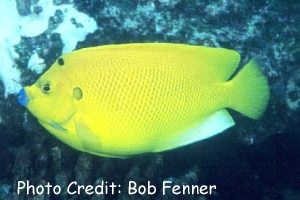
By Bob Goemans

Not Reef Tank Suitable
Likely Fish-Only Tank Suitable
Range: Indian Ocean and Indo-West Pacific Ocean: South Africa east to Samoa and north to southern Japan and southeast to New Caledonia and Australia.
Size: 10 inches (25 cm)
Natural Environment: Inhabits steep reef slopes and dropoffs at depths between 50 – 200 feet (15 – 60 m) and the diet for adults consists mainly of sponges, tunicates, and crustaceans, whereas juveniles graze algae accumulations in more shallow areas.
General Husbandry: This beautiful angelfish has a yellow body and fins, with its mouth edged with blue (like lipstick!). It also has bluish-black spot where the head joins the top of the body and a light tan spot behind the eye.
When first introduced into the aquarium, preferably a well-established fish-only aquarium with lots of live rock and cave areas, it should be offered several daily feedings so as to quickly acclimate it to its surroundings. As to diet, juveniles tend to feed somewhat on algae, whereas adults are more prone to mostly consume sponges, tunicates, and various crustaceans. Therefore a daily diet consisting of a wide variety of frozen foods including fortified brine shrimp, mysis, and especially those containing sponge matter/angelfish food preparations should be offered once or twice a day when acclimated to its surroundings. Yet, since most collected specimens are often still in the juvenile stage, frozen or flake foods, especially those containing Spirulina should also be offered.
Depending upon its tankmates, it can be quite shy when first entering the aquarium, and may hide in caves and crevices. But as time passes, will become more outgoing and begin to establish its territory, yet those in this genus fish are almost always very good tankmates and considered one of the least aggressive in the family.
Taxonomy:
Order: Perciformes
Suborder: Percoidei
Family: Pomacanthidae
Genus: Apolemichthys
FYI: Keeping more than one genus of angelfishes in the same aquarium is possible, yet depends upon several aspects. The following suggested circumstances are just that, possibilities that when heeded and adjusted to actual aquarium conditions ‘may’ make multiple angelfish collections feasible.
Aquarium size – the larger the better.
Other species from the same genus should not be in the same aquarium.
The smallest and most docile genus species should be the first introduced with the largest and most malicious the last to be added.
Do not place similar coloration species in the same aquarium.
Those already in the aquarium should be well fed before adding a newcomer.
Have sufficient hiding places/rocky caves.
Keep in mind all angels have cheekspines at the edge of their gill cover; therefore use caution when handling and also avoid using a net to capture it, as it may become stuck or tangled in the net and become damaged when removed.
Synonym - Apolemichthys armitage
Experience Level: Intermediate
Temperament: Semi-aggressive
Diet: Omnivore
Acclimation Time: 30 minutes+
Aquarium Environment: Fish-only aquarium
Reef Safe: No - will nip clam mantles, large and small polyped stony (LPS/SPS) corals and some soft corals.
Minimum Tank Size: 150 gallons
Temperature Range: 72 - 84°F (22 – 29°C)
Specific Gravity: 1.020-1.026
pH: 8.0 - 8.5
